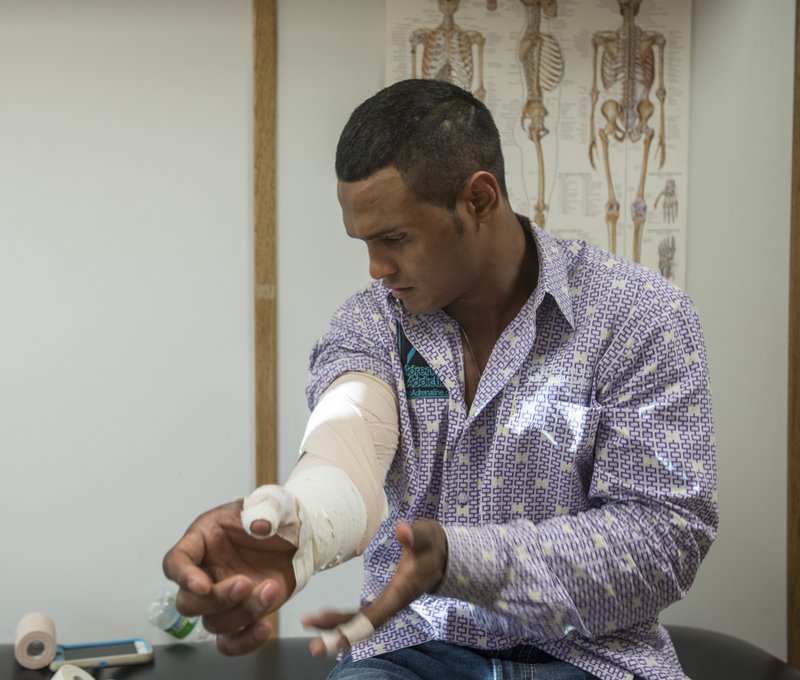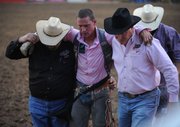Speckled Buck was not kind to Markus Mariluch on Wednesday night. The 2-ton bull sent the Daingerfield, Texas, cowboy flying. Mariluch hit his head, sat upright but unconscious for about 3 seconds and fell to the floor of Parsons Stadium in Springdale.
Mariluch is one of the 400-plus athletes competing at the Rodeo of the Ozarks this week, an event sanctioned by the Professional Rodeo Cowboys Association.
Web watch
Professional Rodeo Cowboys Association
Justin Sportsmedicine Team 2011-14 Injury Study
Mayo Clinic
Neurologic Rehabilitation Institute at Brookhaven Hospital
Consumer Product Safety Commission
Justin Sportsmedicine
Justin Boot Co., a major sponsor of the Professional Rodeo Cowboys Association, developed a mobile sports medicine system in 1980 that provides medical support services free of charge to professional rodeo athletes at arenas where they compete across the country. This sports medicine system links a network of selected emergency physicians, orthopedists, trauma specialists, athletic trainers, physical therapists and massage therapists, as well as hospitals and clinics around the nation to provide comprehensive medical coverage to the professional rodeo contestant.
The sports medicine team averages $3,000 of free medical care to rodeo contestants at each rodeo they serve.
Source: Rick Foster, Program director of the Justin Sportsmedicine Team
Rodeo events
72nd Rodeo of the Ozarks
• Rodeo: 7:30 p.m. tonight, Parsons Stadium, 1423 E. Emma Ave. in Springdale.
• Parade: 10 a.m. today, downtown Emma Avenue in Springdale.
• Fireworks: After the rodeo performance tonight.
• 2017 rodeo dates: June 21-24
• Information: rodeooftheozarks.org, 877-927-6336
Source: Staff report
The Justin Sportsmedicine Team guided the cowboy from the arena after he became coherent. Doug Olle, who travels the country as part of the team, sat Mariluch on a bench behind the chutes, bent to his eye level and began asking questions to determine his consciousness and functioning ability.
Olle, a licensed athletic trainer from Nacogdoches, Texas, and his team closely watched Mariluch for the rest of the evening, returning to ask him more questions, and followed up with him by phone the next day.
Olle reported Thursday that Mariluch, now in Greeley, Colo., suffered no headaches, but decided not to ride in the Xtreme Bulls competition that night at the Greeley Stampede.
"He was very good to listen to me," Olle said. "He's being very smart. He knows he doesn't need to get on. He was concussed pretty good."
Little Britches
The Rodeo Association requires each of its athletes to wear a cowboy hat into the arena to preserve the Western culture that started rodeos. An exception is made for protective helmets and face masks, Olle said.
During the Rodeo of the Ozarks, 18 out of 20 bull riders in the first two nights of competition chose helmets. Most gave their ages in the late teens or early 20s, and they said the youth rodeo associations in which they competed required helmets. It was no big leap to carry their helmets on to professional rodeos, they said.
"I have always worn a helmet," said 19-year-old Garrett Tribble of Bristow, Okla., the first bull rider to ride for the required 8 seconds and earn a score at this year's rodeo. "I've walked away from a lot more situations."
Bull rider Corey Atwell of Moravian Falls, N.H., chose not to wear a helmet Wednesday night.
"I grew up wearing a hat," he said. "I never found a helmet that fit me. They just seem kind of awkward. I probably should."
Atwell is 29, a bit older than most bull riders, and his rodeo heroes of the 1990s didn't wear helmets, so he chooses the same, he said.
"I would have been considered a sissy if I wore a helmet," he said.
"We're still dealing with some of that 'cowboy mentality,' 'cowboy tough,'" Olle said.
Each of these young men said they had been knocked unconscious in previous rodeo competitions, but don't seem to be concerned about lingering effects.
A cowboy might be able to control how he jumps from the bull's back when the whistle blows to mark the end of an 8-second ride, Atwell said.
"But if you're thrown, you take it as it comes and you try to be as safe as you can," Atwell said.
Mariluch echoed the sentiments about 30 minutes after his ill-fated ride.
"It's man versus beast. You need to pick a different sport, if you don't want to be hurt. You're gonna get cracked. And I've never been depressed," Mariluch said.
Concussion Report
The study of the brain of Junior Seau, a renowned linebacker for the San Diego Chargers, after his 2012 suicide showed he suffered chronic traumatic encephalopathy, a neurodegenerative disease associated with head trauma that can lead to dementia, memory loss and depression.
Other prominent player deaths from the disease include Ken Stabler, Frank Gifford, Mike Webster and Tyler Sash at just 27 years old.
"Chronic traumatic encephalopathy is the term used to describe brain degeneration likely caused by repeated head traumas," according to the Mayo Clinic website. "CTE has been found in the brains of people who played contact sports, such as football and boxing, as well as others."
Rodeo is also a contact sport. Most injuries were the result of the cowboy athlete hitting or colliding with the ground, hitting or colliding with the animal during the ride or being stomped by the animal after getting off or being thrown off, the Justin Sportsmedicine Team reported in an injury study released last year.
Cowboys suffered 883 injuries in 2014 serious enough to be treated by the Justin team.
The medical team recorded injuries to 27 body parts, with neurological injuries the fourth most common. Concussions cases were reported 281 times, ranking behind contusions, muscle spasms and muscle strains as the top injuries among cowboys. Bull riders suffered 163 of those concussions -- more than 100 more than suffered by rodeo athletes in any other event.
No Helmets Required
Olle said the head gear worn by cowboys doesn't really protect them from concussions. Rather it protects against facial fractures.
"No helmet design has been proven to prevent concussions," reads the website of the Consumer Product Safety Commission, listing bicycle helmets, motorcycle helmets, football helmets and bull riding helmets along with many others. "The materials that are used in most of today's helmets are engineered to absorb the high impact energies that can produce skull fractures and severe brain injuries. However, these materials have not been proven to counteract the energies believed to cause concussions."
The Professional Bull Riders, another rodeo organization, requires cowboys born after 1994 to wear helmets while competing, but the lead medical staffer for the association said he hasn't seen a drop in the number of brain injuries within the sport, according to a May 2015 report by the Neurologic Rehabilitation Institute at Brookhaven Hospital in Tulsa, Okla.
Mariluch said he wore a helmet "mainly to keep my face from being broken."
The Justin team recommends helmets anyway.
"Bull riders are smaller," Olle said. "You've got a 5-foot, 120-pound guy getting on a 1,500-pound bull."
Nor does he, the Justin Team or the Rodeo Association tell a cowboy he can't ride.
"Cowboys are independent contractors," Olle said. "It's not like the NFL or Major League Baseball. There is no contract."
Chad Fink, a sports trainer with Advanced Orthopaedic Specialists in Fayetteville and a local volunteer for Justin, said a local high school football athlete would be required to sit out of practice and games for a minimum of six days after a concussion.
But six days for a cowboy could mean thousands of dollars in lost income.
"They could go to six rodeos in six days and make $1,000 at each of them," Olle said. "If they don't ride the rope and get the best time, they've got nothing," Olle said.
Olle doesn't see the Rodeo Association requiring helmets any time soon, but he deferred the question to Joe Lufkin, a saddle bronc rider from Sallisaw, Okla.
"I don't think the PRCA will make it mandatory," Lufkin said. "I mean, because we are 'professionals.' That's the difference. We are professionals and can chose what we do coming through the ranks. It's a personal preference."
NW News on 06/25/2016


